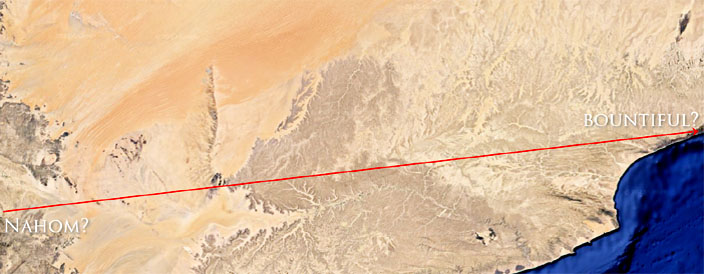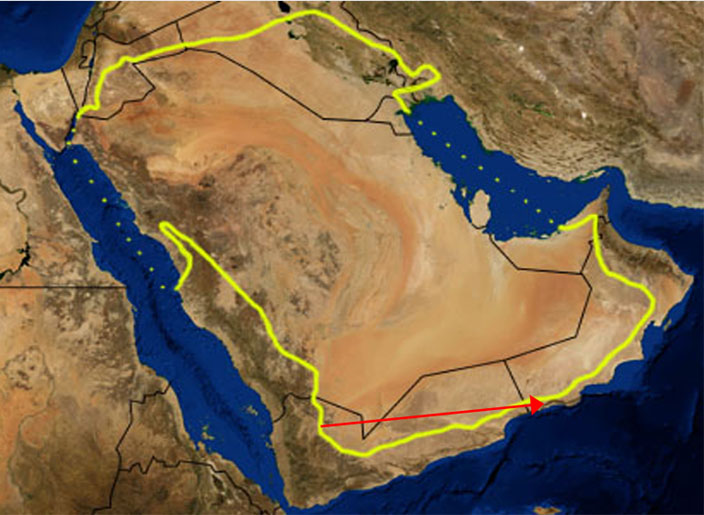The Book of Mormon tells the story of a Jew named Lehi and his family, who leave Jerusalem in 600 BC for the New World. Traveling down the Arabian Peninsula, they stop at a place called Nahom.
Jerusalem to Nahom
After they left Jerusalem, they traveled:- South ‘by the borders near the shore of the Red Sea’. 1 Nephi 2:5
- They pitched tents in ‘Lemuel valley’ next to the ‘River Laman’. Both named after Lehi’s eldest sons. 1 Nephi 2:6, 8, 14; 9:1; 16:6, 12
- Another family and a servant joins them. The families intermarry. 1 Nephi 4:35, 7:5, 16:7
- From this point they travel in a ‘nearly south-southeast direction’—pitching tents along the way—until they reach ‘a place called Nahom’. 1 Nephi 16:12-17, 33-34
- From Nahom they turn and travel in a ‘nearly eastward’ direction. 1 Nephi 17:1
- They arrive at their final destination on the Arabian Peninsula. It is a tropical paradise along the eastern coast. They name it ‘Bountiful’ for its abundant fruit and honey. Here they construct a ship to take them to the New World. 1 Nephi 17:5; 18:2, 23

Book of Mormon: Lehi's migration to the New World?
Nahom = Nihm?
Some Mormon apologists see a link between the Book of Mormon’s Nahom and the name of the Nihm tribe in Yemen. This Nihm tribe is located about 43-miles northeast of Sana'a, the capitol of Yemen.- This link is made on the basis that Semitic languages do not use vowels, therefore the consonant spelling of Nahom (NHM) can be compared to Nihm (NHM).
- A linguistic link is an assumption.

The exact equivalency of the root letters cannot be assured. It is probable that the term Nahom was spelled with the rasped or fricative Hebrew letter for "h" (het or chet) whereas the name Nihm, both in modern Arabic and in the ancient Sabaean dialect, is spelled with a softer, less audible h sound... One has to assume, it seems to me, that when the members of Lehi's party heard the local name for "the place that was called Nahom" they associated the sound of that local name with the term Nahom, a Hebrew word that was familiar to and had meaning for them. | |
 | — S. Kent Brown
Director of the BYU Jerusalem Center |
- Further complicating a Hebrew link is the fact that the Book of Mormon claims to have been written in Reformed Egyptian.

And now, behold, we have written this record according to our knowledge, in the characters which are called among us the reformed Egyptian. | |
 | — Mormon
|

Book of Mormon: seven years travel across the desert from Nahom to Bountiful.
In the Book of Mormon narrative, the locations of Nahom and Bountiful are inextricably linked. With Bountiful being ‘nearly eastward’ from Nahom. 1 Nephi 17:1
- It is highly likely that a group of Jews traveling down the Arabian Peninsula would have followed the ancient Incense Trade Route. It would have been suicide to abandon the routes’ watering holes to cut east across the Empty Quarter.

The Arabian Desert as delineated by the WWFN. The Rub' al Khali, aka 'Empty Quatert', considered impassible, comprises the bottom third of the Arabhian Desert. It is the world's largest sand sea. Lehi's seven year 'nearly eastward' journey from the proposed Nahom to Bountiful locations in red.
- The narrative states that it took Lehi and company eight years to reach Bountiful from Jerusalem. 1 Nephi 17:4-5
- A Mormon apologist places the time it took them to reach Nahom at about a year.

I believe that it took them about a year to go from their first base camp down to Nahom. The reason is because that's when Nephi mentions the birth of the first children. | |
 | — S. Kent Brown
Director of the BYU Jerusalem Center
|
- If it took them one year to reach Nahom, means it took them seven years to reach Bountiful. That’s seven years crossing the deadly Arabian Desert. Mormon apologists admit how daunting travel through this desert is.

They're going in an area that no one in his right mind would have gone. This space in the Arabian desert, out in a wilderness where you can barely survive four or five hours without water. | |
 | — Truman G. Madsen
Professor of Religion and Philosophy, BYU |
A Tribe Place Called Nahom
The name of a tribe doesn’t give us the name of a place in 600 BC called Nahom. To get there:
- Mormon apologists point to a 7th-6th century BC altar inscribed with ‘NHM’ in Sabaean script—which may be translated ‘Nihmite’—as a clue that Lehi could have crossed paths with the Nihm tribe. The altar is located at the Bar’an Temple in Marib, Yemen, about 76-miles east of Sana’a.
- For a place named after the tribe, Mormon apologists point out that some maps of Arabia that date from about 1750-1850 AD have ‘Nehem’ / ‘Nehhm’ / ‘Nehm’ located in the same general area north or northeast of Sana’a. It is unknown if Joseph Smith had access to these maps before publishing his Book of Mormon in 1830.

Nehhm is a small district... the present Shiech [Sheikh]... possesses a few small inconsiderable towns, with a fertile mountain, on which are many villages. | |
 | — Carsten Niebuhr
German Cartographer |
Conclusion
After a deep-dive look at all of the evidences pieced together by LDS apologists, it is not unreasonable to consider that the modern Nihm tribe, the ancient Sabaean ‘NHM’ inscription, and 270-year-old maps with Nehem / Nehhm may all be connected.
- Regardless, if the Book of Mormon’s Nahom was a place named after the Nihm tribe in Yemen 2,600-years ago remains a matter of conjecture.
- For many devout Mormons, the evidence for Nahom is the most promising for a Book of Mormon location.
- For skeptics, the fact that the best evidence for a book largely about the New World is a 3-letter consonant spelling in the Middle East; that hundreds of Book of Mormon locations remain unknown; and that the LDS church will not endorse this location, tips the scales.
- Even if we entertain this theory, we then have to make the leap that Lehi and company survived seven years crossing the Arabian Desert on their way to Bountiful.






